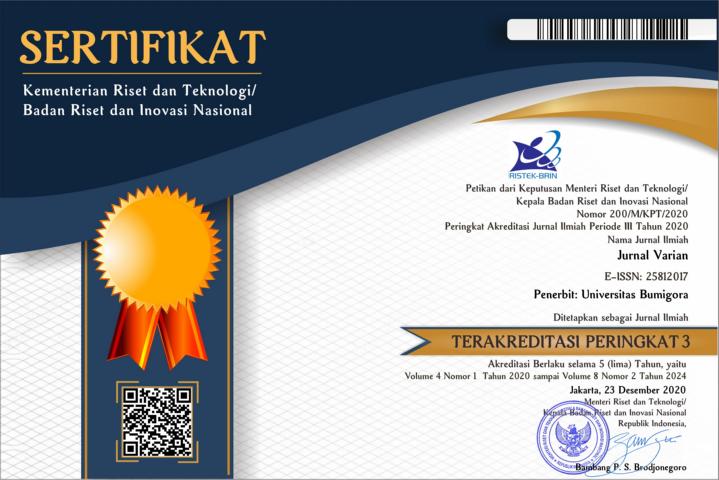Analysis of Underdeveloped Regency Using Logistic Threshold Regression Model
DOI:
https://doi.org/10.30812/varian.v8i1.3570Keywords:
HDI, Threshold Regression, Underdeveloped RegencyAbstract
Regional development inequality causes some regions to lag behind other regions. An underdeveloped
regency is a regency where territories and people are less developed than other regions nationally. The
government has set a Human Development Index (HDI) target of 62.2 to 62.7 to accelerate the development of underdeveloped regency and prevent the regions from lagging. This study aims to evaluate
the HDI target and obtain the HDI value that reduces the risk of underdeveloped regency and acquires
variables that affect underdeveloped regency’s status. The logistic threshold regression model is used
in this study with HDI as the threshold variable, 22 indicators for determining underdeveloped regency
as explanatory variables, and the underdeveloped regency’s status as the response variable. Threshold
regression can handle non-linear relationships between response and explanatory variables, including
various types of threshold models such as step, segmented, hinge, stegmented, and upper hinge. By applying a hinge threshold regression model using the R package ’chngpt,’ this study addresses non-linear
relationships and categorical responses. The results showed a threshold effect with a threshold value of
62.9, indicating that the HDI target can reduce the region’s risk of being left behind.
References
Evidence from Mozambique. Health Economics Review, 5(1), 26. https://doi.org/10.1186/s13561-015-0062-6
BPS. (2022). Indeks Pembanguan Manusia 2021.
BPS. (2023). Produk Domestik Regional Bruto Provinsi-Provinsi di Indonesia menurut Pengeluaran 2018-2022.
Elder, A., & Fong, Y. (2019). Estimation and inference for upper hinge regression models. Environmental and Ecological Statistics, 26(4), 287–302. https://doi.org/10.1007/s10651-019-00428-1
Fitrah, R., Asdi, Y., & Maiyastri, M. (2021). Pemodelan Faktor-Faktor yang Mempengaruhi Status Daerah di Indonesia Menggunakan
Metode Regresi Logistik Biner. Jurnal Matematika UNAND, 10(1), 108. https://doi.org/10.25077/jmu.10.1.108-
115.2021
Fong, Y., Huang, Y., Gilbert, P. B., & Permar, S. R. (2017). Chngpt: Threshold regression model estimation and inference. BMC
Bioinformatics, 18(1), 454. https://doi.org/10.1186/s12859-017-1863-x
Gujarati, D. N., & Porter, D. C. (2012). Basic Econometrics. McGraw-Hill/Irwin.
Hasan, Z. (2022). The Effect of Human Development Index and Net Participation Rate on the Percentage of Poor Population: A
Case Study in Riau Province, Indonesia. International Journal of Islamic Economics and Finance Studies. https :
//doi.org/10.54427/ijisef.964861
Hermawan, A. (2019). Analisis Distribusi Tenaga Kesehatan (Dokter Perawat Dan Bidan) Di Indonesia Pada 2013 Dengan Menggunakan Gini Index. Buletin Penelitian Sistem Kesehatan, 22(3). https://doi.org/10.22435/hsr.v22i3.1304
Hochard, J., & Barbier, E. (2017). Market Accessibility and Economic Growth: Insights from a New Dimension of Inequality. World
Development, 97, 279–297. https://doi.org/10.1016/j.worlddev.2017.04.018
Hosmer, D. W., Lemeshow, S., & Sturdivant, R. X. (2013). Applied logistic regression (Third edition). Wiley.
Kemendes PDTT. (2019). Dukungan Infrastruktur untuk Daerah Tertinggal.
Kennedy, P. E. (2005). Oh No! I Got the Wrong Sign! What Should I Do? The Journal of Economic Education, 36(1), 77–92.
https://doi.org/10.3200/JECE.36.1.77-92
Kyriacou, A. P., Muinelo-Gallo, L., & Roca-Sagales, O. (2015). Fiscal decentralization and regional disparities: The importance of ´
good governance. Papers in Regional Science, 94(1), 89–108. https://doi.org/10.1111/pirs.12061
Maulidina, T. P., & Oktora, S. I. (2020). Analisis Spasial Ketertinggalan Daerah di Indonesia Tahun 2018 Menggunakan Geographically Weighted Logistic Regression. Indonesian Journal of Statistics and Its Applications, 4(3), 528–544. https://doi.
org/10.29244/ijsa.v4i3.690
Otok, B. W., Hidayat, R., Mahsyari, Z., Sa’diyah, S. H., & Fadhila, D. A. (2018). Classification of Underdeveloped Regions in
Indonesia Using Decision Tree Method: Proceedings of the 2nd International Conference Postgraduate School, 879–
883. https://doi.org/10.5220/0007553308790883
Pratama, Y. C. (2014). Analisis Faktor-Faktor yang Mempengaruhi Kemiskinan di Indonesia. Esensi: Jurnal Bisnis dan Manajemen, 4(2). https://doi.org/10.15408/ess.v4i2.1966
Pudjianto, B., & Syawie, M. (2015). Kemiskinan dan Pembangunan Manusia. Sosio Informa, 1(3). https://doi.org/10.33007/inf.
v1i3.167
Purwandari, T., & Hidayat, Y. (2017). Pemodelan Ketertinggalan Daerah di Indonesia Menggunakan Analisis Diskriminan, 194–200.
https://scholar.google.com/scholar?cluster=16071151654119604742&hl=en&oi=scholarr
Shoesmith, D., Franklin, N., & Hidayat, R. (2020). Decentralised Governance in Indonesia’s Disadvantaged Regions: A Critique of
the Underperforming Model of Local Governance in Eastern Indonesia. Journal of Current Southeast Asian Affairs,
39(3), 359–380. https://doi.org/10.1177/1868103420963140
Sofilda, E., Hamzah, M., & Sholeh, A. (2014, January). Human Development and Poverty in Papua Province (An Analysis of Simultaneous Approach on Panel Data Regression). Retrieved October 29, 2024, from https://papers.ssrn.com/abstract=2382080
Todaro, M. P., & Smith, S. C. (2020). Economic Development. Pearson UK.





















